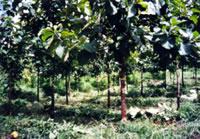Tree Spacies for Reforestation
![]()
 |
 |
| Teak | |
| Local Name: | SAK |
| Botanical name: | Tectona grandia L. fil. |
| Family: | Verbenaceae |
| Origin: | Southeast Asia |
| Distribution: | India, Myanmar, Thailand, Laos, and elsewhere |
| Uses: | Teak is highly valued for its durability, hardness, and low coefficient of contraction. It is used for fine furniture and sculptures, in shipbuilding, and for high-grade decorations, flooring, and door and window frames. |
| Description: | Teak is a medium-fast developing tree, showing particularly rapid growth during the young period. At favorable sites it may grow 40 to 45m high with a clear trunk up to 25 to 30m. Occasionally, in native forests it may reach a height of 60 m, and in favourable areas may have a diameter of 60 to80cm. Teak has a round crown and ovate leaves that are downy on the underside and measure 30 to 75 cm long and 14 to 40 cm across. Many bluish-white flowers are formed in 30 to 35 cm panicles, and its dark brown, spherical seeds have a hard coat. In Thailand, teak generally undergoes a deciduous period from November through January with new budding from April to May and flowering during the rainy season from June and July. |
| The wood: | Teak's inner color is golden to dark brown, sometimes reddish brown. The wood contains natural oils, giving it great durability and resistance to moisture and dryness under severe weather conditions. Due to its hardness and durability it has a low coefficient of contraction. |
| Propagation: | By seeds and (in Thailand) from cuttings treated with special hormones. |